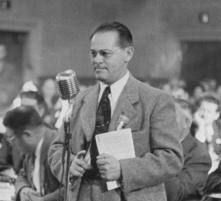
On March 8, 1908, some ten thousand women workers in the needle trades, mostly Jewish and Italian, took to the New York City streets to demand higher wages, shorter hours, and an end to child labor. This demonstration helped spark the establishment of March 8th as International Women’s Day in 1911.
Ninety years ago, in 1926, also on March 8, amid a massive strike of fur workers in New York, Ben Gold, Communist leader of the Fur and Leather Workers Union, called out 10,000 workers, mostly women, for mass picketing. Ultimately, the strikers won a 10 percent raise and a 40-hour, five-day work week.
The New York Furriers’ Joint Board contract expired on January 31, 1926. Among the union’s demands were a reduction in working hours to the five-day, 40-hour work week; union inspection of shops; a 25 percent wage increase; an employer contribution of 3 percent of each worker’s salary to an unemployment insurance fund; a single paid holiday; and equal division of work among employees to eliminate favoritism. The employers’ association refused to negotiate over the work week, unemployment fund or equal division of work, but agreed to seek a settlement on the other terms if the union would withdraw the other three demands.
Exploiting internal union disputes between socialists and communists, the employers instituted a lockout of 8,500 workers on February 11th, to which the union responded by calling a general strike of all 12,000 fur workers in the city on February 16th.
The strike quickly turned violent. On February 19, New York City police attacked a picket line of striking workers and arrested 200. On March 8, Gold called out 10,000 workers for mass picketing throughout the furriers’ district. Police used clubs to beat hundreds of strikers, and then drove cars at high speed into the crowd to try to break up the pickets. Only when Gold ordered the picket to break up were law enforcement authorities able to regain control. The police response was so brutal that a city magistrate later excoriated the police department for “undue coercion” against the striking workers.
On March 13, a New York state judge refused to grant the employers an injunction which would force an end to the strike. In mid-April, the Eitingon-Schild Company, the wealthiest fur importer in the United States – most of their furs came from the new Soviet Union – broke with the employers’ association to settle with the union. The company agreed to a five-day, 40-hour work week; equal division of work; no subcontracting; and a 10 percent wage increase.
But the strike continued despite this agreement. In early April, AFL organizer Hugh Frayne met with a moderate faction within the Joint Board, who asked AFL President William Green to personally intervene in the strike. But when their proposal for a 42-hour work week and a 10 percent wage increase was presented to the membership on April 15, they overwhelmingly rejected it. The AFL barred Ben Gold from the meeting, but the membership chanted his name and nearly rioted until he was admitted to the hall. In part, the workers rejected the proposal because they had had no hand in making it. But they also rejected the proposal because it did nothing to help Jewish workers, who needed the five-day work week provision in order to protect their Saturday Sabbath.
In retaliation for the moderates’ attempt to end-run the local leadership, and to increase pressure on the employers, Gold asked the Joint Board to initiate a drive for the 40-hour work week which would involve every union in the city. The Board agreed, and soon the New York State Federation of Labor, the Amalgamated Clothing Workers of America, the Teachers Union, the International Ladies’ Garment Workers’ Union, and a number of other unions agreed to join the effort. On May 22, 1926, a mass rally filled the newly built Madison Square Garden, making it the largest labor meeting held in the city up to that time. Gold denounced labor leaders who did not attend, and declared that winning the 40-hour work week in New York City would lead to a nationwide movement which would gain traction throughout the nation.
The drive for the 40-hour work week pushed the employers to agree to a new collective bargaining agreement. A new contract was reached on June 11, 1926, providing for the 40-hour, five-day work week; an end to overtime from December through August; time-and-a-half overtime pay for half-days from September to November; a 10 percent wage increase; 10 paid holidays; and a ban on subcontracting.
Sources including photo: Wikipedia, Jewish Currents. (In photo: Ben Gold)










